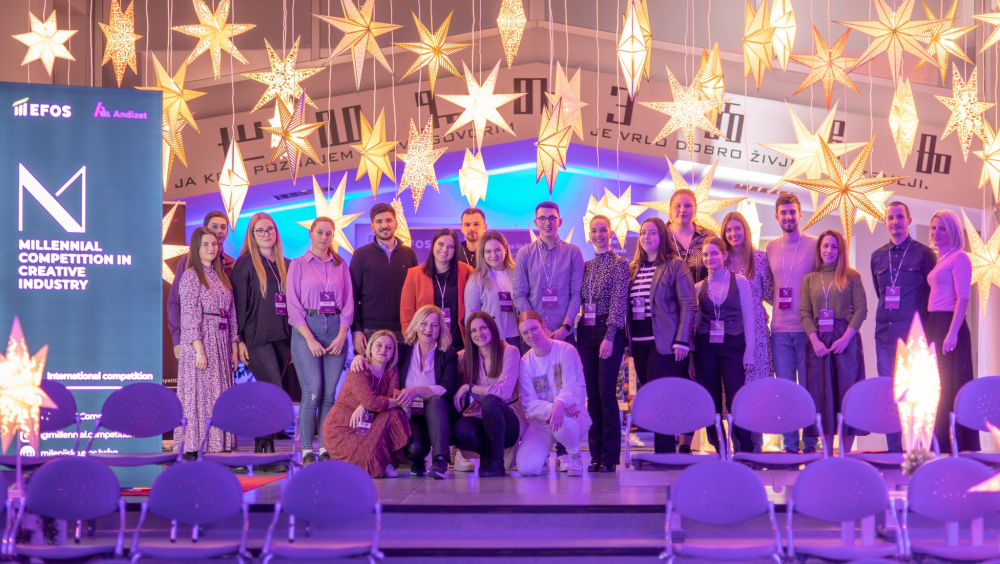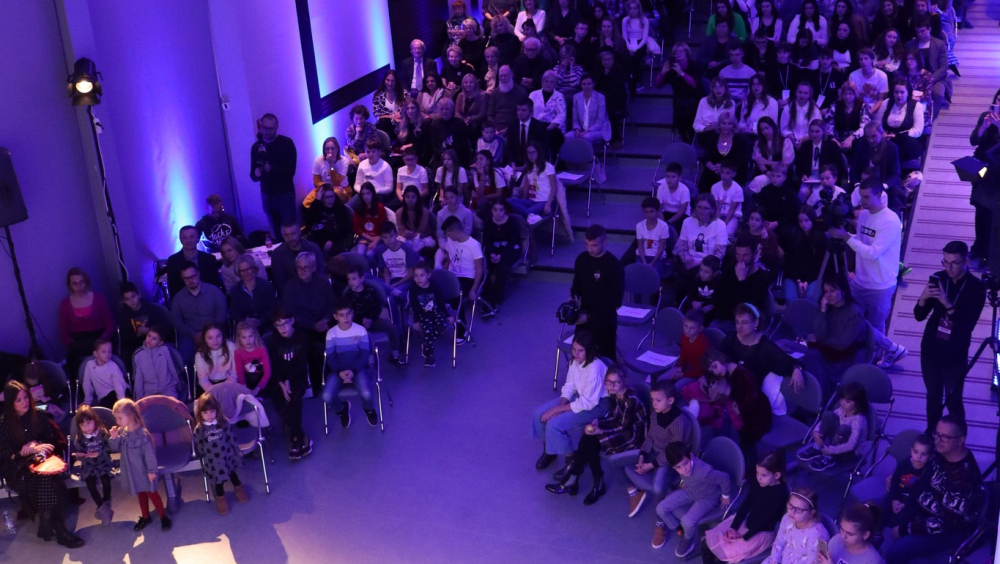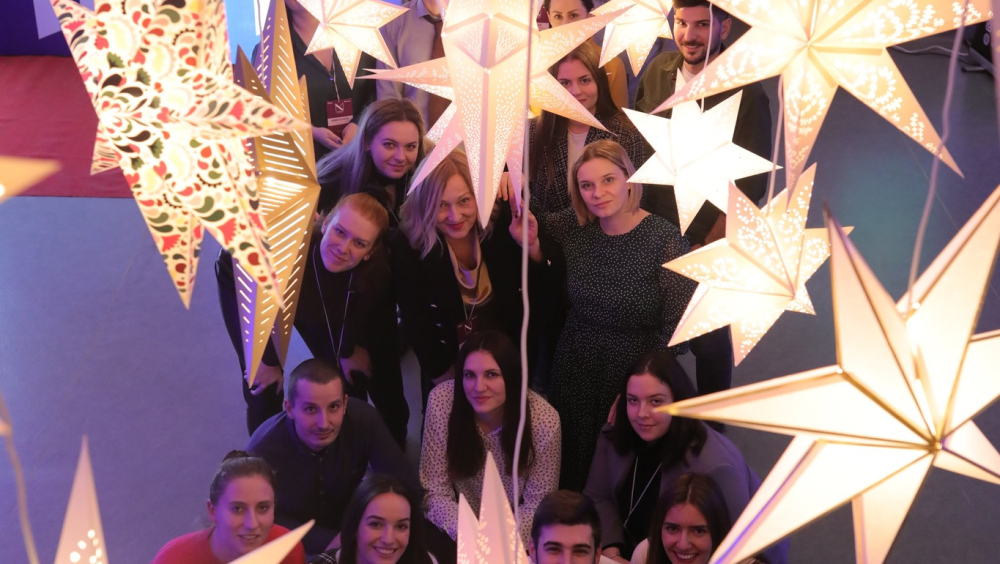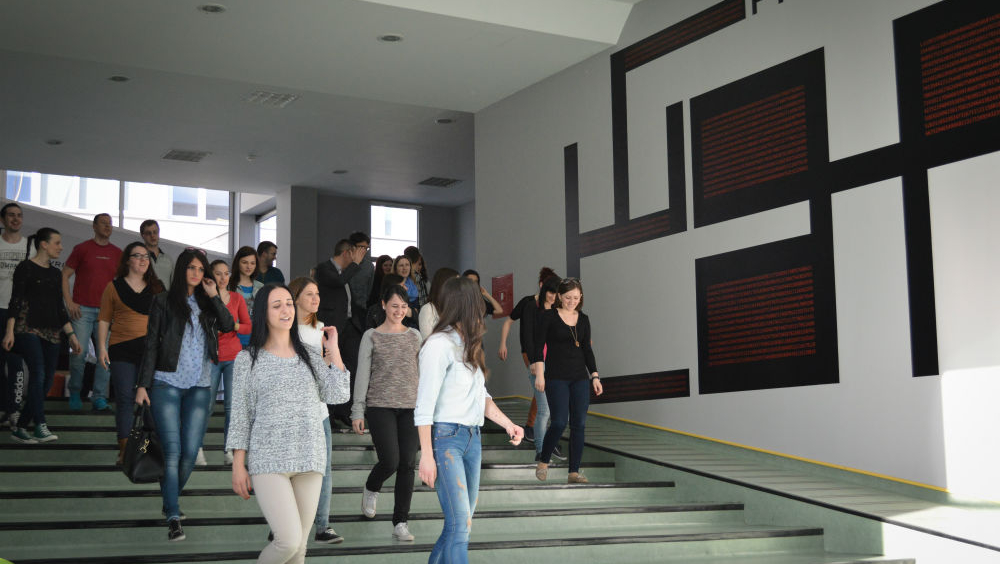Croatian Glagolitic script - a perpetuum mobile of European cultural creativity
The Glagolitic script is an ancient script whose origin is connected with the year 863 and the religious and enlightenment mission of St. Cyril - the creator of the script - and his brother Methodius. This script was once widely used in the countries of today’s European Union and is also a long-standing cultural link between European countries. A valuable dimension of the Glagolitic script is that it simultaneously promotes literacy and conveys Christian messages using images, numbers, letters and symbols. The creativity of the Glagolitic script is the result of its diverse functionality and the desired effect on the communication skills of younger age groups.
With its murals of the meandered Glagolitic script and the international Millennium Competition in the Creative Industry, the Faculty of Economics in Osijek invites young people to get acquainted with the Glagolitic script in order to offer their own conceptual solutions for popularising this valuable cultural heritage. The most successful competitors receive the Hydrogen Award and become shining examples of their communities, which consequently increases interest in the creativity of the young winners, and their conceptual solutions proactively revive the cultural heritage.
The installation of the murals of the meandered Glagolitic script in the premises of the Faculty of Economics in Osijek in 2015 was a museumisation of the Croatian Glagolitic script described in the novel Az published in 2009. The author of the novel, Jasna Horvat, offered conceptual solutions for the murals of the meandered Glagolitic script, and their installation in the premises of the Faculty of Economics was realised by Josipa Mioč. The initial surprise of the students was replaced by curiosity, making the Faculty of Economics in Osijek introduce interpretive tour guiding, in which the murals were connected through narration with the creation of the Glagolitic script.
The murals of the meandered Glagolitic script vividly brought to life the written history dating back to the 9th century and the mission of St. Cyril and Methodius, known as the Holy Brothers. The mission of the Holy Brothers was to Christianise the Slavic tribes, but at the same time to enable them to read and write. Therefore, in order to overcome linguistic misunderstandings, a pictographic script invented by St. Cyril was used to teach people how to read and write and to Christianise them through his pictographic code. The Glagolitic script spread throughout Europe and united linguistically separated tribes.
Being in the premises of a higher education institution painted with artistic murals inspired by the Glagolitic script encouraged the young people to offer their own creative interpretations of the ancient Croatian script. This interest of the economics students in the murals of the meandered Glagolitic script led to the organisation of the Millennium Competition in the Creative Industry and the call of the Faculty of Economics in Osijek to young people to offer their conceptual solutions for the life of the Glagolitic script in the new millennium. The signal sent by economists to the young people was that it is desirable to draw from the cultural heritage and at the same time to develop their own creative solutions related to the sectors in the creative industry. In addition to the Glagolitic script, the young people were offered three other competitive topics, namely mythology, the Silk Road, and hydrogen - the fuel of the future. The number and variety of conceptual solutions grew year by year, and the arrival of the competitors on the premises of the Faculty of Economics increased the tours of the faculty. A symbolic message of the first nine Glagolitic signs was regularly emphasised during these tours: “I[1], who know[2] the letters[3], say[4] that it is[5]good[6] to live[7] honourably[8] in this world![9]“
With its historical foundation, the Glagolitic script is a reminder of the longevity of connections in Europe, and the Millennium Competition in the Creative Industry is a reminder of the importance of creativity in the youngest age groups.
As one of the original topics, the Glagolitic script attracted a large number of young competitors, and as solutions from abroad were also offered, the Millennium Competition in the Creative Industry evolved from a national to an international competition.
[1] A – (AZЪ, number 1) – the first Glagolitic sign (symbolic meaning “I, a Christian”).
[2] V – (VÊDÊ, number 3) – the third Glagolitic sign (symbolic meaning “know”).
[3] B – (BUKY, number 2) – the second Glagolitic sign (symbolic meaning “letter”, “logos”).
[4] G – (GLAGOLJǪ, number 4) – the fourth Glagolitic sign (symbolic meaning “speak”).
[5] E – (ESTЪ, number 6) – the sixth Glagolitic sign (symbolic meaning “is”).
[6] D – (DOBRÊ, number 5) – the fifth Glagolitic sign (symbolic meaning “good”).
[7] Ž – (ŽIVÊTI, number 7) – the seventh Glagolitic sign (symbolic meaning “live”).
[8] Ʒ – (ƷÊLO, number 8) – the eighth Glagolitic sign (symbolic meaning “virtue, honour”).
[9] Z – (ZEMLI, number 9) – the ninth Glagolitic sign (symbolic meaning “Earth”).
The Croatian Glagolitic script is a version of the script created in 863 with the aim of Christianising the Slavic tribes scattered throughout Eastern and Central Europe. Such a pan-European endeavour is a confirmation of centuries-old European interconnectedness on spiritual, educational and intellectual levels. With its unique and angular forms, the Croatian Glagolitic script testifies to the tradition of preserving cultural diversity within European integration while promoting at the same time common values. The international Millennium Competition in the Creative Industry encourages young people to get acquainted with the Glagolitic script, a multi-coded script capable of conveying messages in alphabetical, numerical and symbolic codes. It is especially important to remember that the first nine Glagolitic signs convey a message that is still on the trail of European values, namely: “I[1], who know[2] the letters[3], say[4] that it is[5] good[6] to live[7] honourably[8] in this world![9]“
Following the knowledge gained from cultural tradition, young people are encouraged to improve modern means of communication. The conceptual solutions offered at the Millennium Competition in the Creative Industry also form a basis for creative ideas on the topic of the Glagolitic script and a foundation for future products intended for the market. Popularisation of cultural identity lying in the background of the ancient script raises awareness among young people of the importance and potential of cultural heritage and the possibilities of its presence in a modern environment. Through the understanding and revitalisation of cultural heritage, young people benefit from the advantages that arise from the foundation of European togetherness.
[1] A – (AZЪ, number 1) – the first Glagolitic sign (symbolic meaning “I, a Christian”).
[2] V – (VÊDÊ, number 3) – the third Glagolitic sign (symbolic meaning “know”).
[3] B – (BUKY, number 2) – the second Glagolitic sign (symbolic meaning “letter”, “logos”).
[4] G – (GLAGOLJǪ, number 4) – the fourth Glagolitic sign (symbolic meaning “speak”).
[5] E – (ESTЪ, number 6) – the sixth Glagolitic sign (symbolic meaning “is”).
[6] D – (DOBRÊ, number 5) – the fifth Glagolitic sign (symbolic meaning “good”).
[7] Ž – (ŽIVÊTI, number 7) – the seventh Glagolitic sign (symbolic meaning “live”).
[8] Ʒ – (ƷÊLO, number 8) – the eighth Glagolitic sign (symbolic meaning “virtue, honour”).
[9] Z – (ZEMLI, number 9) – the ninth Glagolitic sign (symbolic meaning “Earth”).





